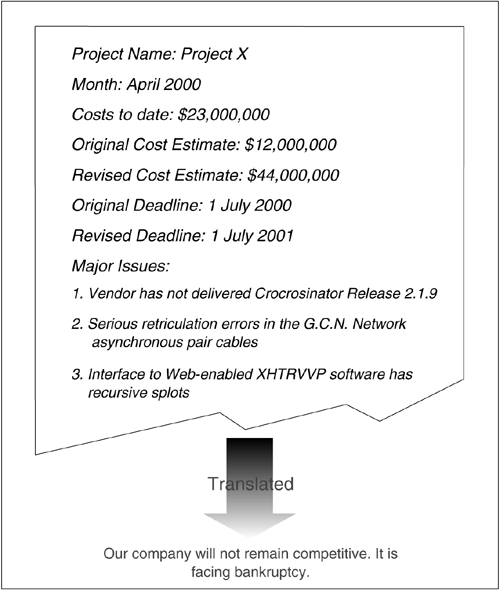Rule 4: In the Absence of Information, Executives Still Make Decisions
| Since the 1970s, experts in executive decision making such as Henry Mintzberg (1973) have proven that executives prefer "informal"modes of communication such as face-to-face discussions and meetings to "formal" modes of communication such as reports , metrics, and statistics. With the increasing pressures of competition, deregulation , takeovers, mergers, and economic rationalism, most executives that we work with are under substantially more pressures than those studied in the 1970s by Mintzberg. As a result, their reliance on informal and fast communication has increased. For you as a project manager, this is an important understanding. Your executives will make decisions based on either good information or bad data. You decide what they get! It has been our experience that the typical executives in project sponsor roles operate in an information vacuum . One example of this rule occurs in the approval of new projects. Many of the organizations with which we are familiar have established "filters" for executive information. For example, the senior executive committees are only given information on the really large projects. One company we have worked with had a guideline that senior executives only approved and reviewed projects over $5 million. As a result of this guideline, the executive steering committee had information on only 12 projects. There were more than 200 other projects underway in that IT organization that were not reported on at all. These "smaller" projects were consuming over 50% of the IT resources. It is completely understandable, given the information vacuum that this executive committee worked in, that they would continuously approve new IT projects when there were no IT resources to allocate to the project. After all, they were only seeing a fraction of the picture. Another example of this rule is shown in the area of project reporting. In discussions with a number of executives, we have determined that most of them do not read the complex project status reports that are sent to them on a monthly basis (see Figure 20.3). Worse, many of these executives report to us that even when they do read them, they either don't understand them or don't believe them! After all, do you? Figure 20.3. Data not information As a project manager, you must learn to communicate to your project sponsor in short, information-rich messages. In general, most project sponsors want to know two things: The first is, "Is the project OK or not OK?" (what is meant by "OK" would be determined by the specific agreed-on business case or project charter developed at the beginning of the project). The second piece of information is, "If it is not OK, what must the sponsor do to assist the project manager in fixing it up?" This rule also applies to issues of business alignment, cost “benefit analysis, project risk management, estimation, and other critical project management information. For example, if the project risk analysis, benefits analysis, and estimation have been done poorly, it is rare that a senior business executive would have either the time, information available, or expertise to discover the errors (see Rules 5 and 6). In effect, faced with poorly developed and presented information, the executive will simply operate on "gut feel," informal information, and organizational political concerns to make the project decision. |
EAN: 2147483647
Pages: 136
